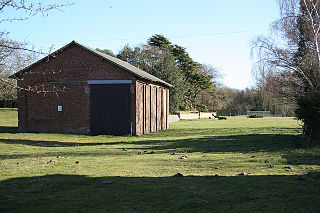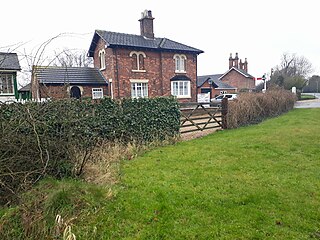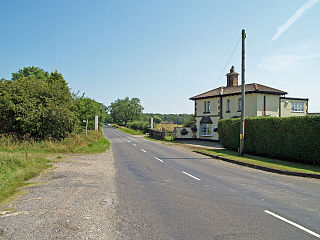Related Research Articles

The Lincolnshire Wolds Railway (LWR) is a heritage railway based at Ludborough station, near Louth, Lincolnshire, England and the only standard gauge steam railway in Lincolnshire open to the public. The line is part of the original Great Northern Railway (GNR), a rail system that opened in 1848 and once linked Grimsby, Louth and East Lincolnshire with London. In early 2002, 2009 and 2013 the Lincolnshire Wolds Railway received a top national award from the Heritage Railway Association for its heritage railway efforts.

Ludborough is a heritage railway station in Ludborough, Lincolnshire, England, which is the base of the Lincolnshire Wolds Railway. The station, which was previously part of the East Lincolnshire Railway, closed in 1961 to passengers and 1964 to freight, but was taken over by the preservation society in 1984. The first trains from the station to North Thoresby, to the north, ran in August 2009, the first for 47 years. There are proposals to extend the line further in both directions towards Holton-le-Clay and Louth.

Aby for Claythorpe was a railway station on the East Lincolnshire Railway which served the hamlets of Aby and Claythorpe in Lincolnshire between 1848 and 1961. It originally opened as Claythorpe, but was renamed in 1885. Withdrawal of goods facilities took place in 1961, on the same day that the station was closed to passengers. The line through the station is closed.

East Ville was a railway station on the East Lincolnshire Railway which served the village of Eastville in Lincolnshire between 1848 and 1964. It originally opened as East Ville and New Leake, but was renamed in 1850. Withdrawal of passenger services took place in 1961, followed by goods facilities in 1964. The line through the station remains in use as the Poacher Line

Little Steeping was a railway station on the East Lincolnshire Railway which served the hamlet of Little Steeping in Lincolnshire between 1848 and 1964. It became a junction station in June 1913 when the Kirkstead and Little Steeping Railway was opened to provide a more direct route to Skegness for East Midlands holidaymakers. Withdrawal of passenger services took place in 1961, followed by goods facilities in 1964. The line through the station remains in use as the Poacher Line, although the Kirkstead and Little Steeping Railway closed throughout on 5 October 1970.

Burgh-le-Marsh was a railway station on the East Lincolnshire Railway which served the village of Burgh le Marsh in Lincolnshire between 1848 and 1970. It originally opened as Burgh, but was renamed in 1923. Withdrawal of goods facilities took place in 1966, followed by passenger services in 1970. The line through the station is now closed.

Willoughby was a railway station on the East Lincolnshire Railway which served the village of Willoughby in Lincolnshire between 1848 and 1970. In 1886, a second larger station replaced the first following the opening of a junction with the Mablethorpe Loop Line to Sutton-on-Sea and later Mablethorpe. The withdrawal of goods facilities at Willoughby took place in 1966, followed by passenger services in 1970. All lines through the station are now closed.

Alford Town was a railway station on the East Lincolnshire Railway which served the town of Alford in Lincolnshire between 1848 and 1970. It originally opened as Alford, but was renamed in 1923. When passenger services were withdrawn in 1970 the line through the station was closed.

Authorpe was a railway station on the East Lincolnshire Railway, which served the village of Authorpe in Lincolnshire between 1848 and 1964. The station was closed to passengers in 1961, and withdrawal of goods facilities took place in 1964. The line through the station is closed.

Legbourne Road was a railway station on the East Lincolnshire Railway which served the village of Legbourne in Lincolnshire between 1848 and 1964. The station was closed to passengers in 1953, and withdrawal of goods facilities took place in 1964. The line through the station closed in 1970. The station once housed a museum containing railway memorabilia; this closed in 1998 and the building is once again a private residence.

Holton Village Halt was a railway halt on the East Lincolnshire Railway which served the village of Holton-le-Clay in Lincolnshire between 1905 and 1961. The station, which opened as part of a new motor train service between Grimsby and Louth, was the second station to serve the village after Holton-le-Clay and Tetney situated further to the south. The line through Holton-le-Clay remained open for freight until December 1980.

Holton-le-Clay was a railway station on the East Lincolnshire Railway which served the English villages of Holton-le-Clay and Tetney in Lincolnshire between 1848 and 1964. It was originally named Holton-le-Clay and Tetney, but Tetney was dropped soon after opening, even though the station was more conveniently sited for that village. The line through Holton-le-Clay remained open for freight until December 1980, but could be reopened by the Lincolnshire Wolds Railway as its northern terminus.

North Thoresby is a heritage railway station in North Thoresby, Lincolnshire. The station, which was previously part of the East Lincolnshire Railway, closed in 1970, but has since been reopened by the Lincolnshire Wolds Railway. The first services to the station from Ludborough, to the south, ran in August 2009, the first in 47 years. The LWR aims to extend the line further in both directions, northwards as far as Holton-Le-Clay and southwards to Louth.

Utterby Halt was a railway halt on the East Lincolnshire Railway which served the village of Utterby in Lincolnshire between 1905 and 1961. The station, which opened as part of a new motor train service between Grimsby Town and Louth, is reputed to be haunted by the ghost of a ganger killed on the level crossing in 1953. The line through Utterby remained open for freight until December 1980.

Fotherby Halt was a railway halt on the East Lincolnshire Railway which served the village of Fotherby in Lincolnshire between 1905 and 1961. The station was opened on the site of a previous station named Fotherby Gate House which had closed in 1872. The second station closed in 1961, but the line through it remained open for freight until December 1980. The line through the station could be reopened by the Lincolnshire Wolds Railway as part of its extension south from Ludborough to Louth.

New Holland Pier railway station is a former railway terminus in North Lincolnshire, England. It stood at the seaward end of the New Holland Pier, which juts 1,375 feet (419 m) northwards into the River Humber at the village of New Holland. Its purpose was to enable railway passengers, vehicles and goods to transfer to and from ferries plying between New Holland and Hull.

Grainsby Halt was a railway halt on the East Lincolnshire Railway which served the hamlet of Grainsby in Lincolnshire between 1905 and 1952. The station, which opened as part of a new motor train service between Grimsby and Louth, was opened to serve a Victorian hall situated 2 miles (3.2 km) to the west. The station, one of the smallest to be taken over by British Railways on nationalisation in 1947, never really justified its existence and closed in 1952 following a period of temporary closure during the Second World War. The line through Grainsby remained open for freight until December 1980.
Weelsby Road Halt was a railway halt on the East Lincolnshire Railway which served the Weelsby Road area of eastern Grimsby in Lincolnshire between 1905 and 1940. The station was opened as part of a new motor train service between Grimsby and Louth. It was the site of major works in 1933 when a plate girder bridge was constructed to replace a level crossing, enabling road traffic to pass underneath through a subway. The station closed in 1952 following a period of temporary closure during the Second World War. The line through Weelsby remained open for freight until December 1980. The trackbed was later reused by Humberside County Council to construct the A16 Peaks Parkway which now runs through the site. Building of the road put an end to the aspirations of the Great Northern and East Lincolnshire Railway plc to reopen the line as a heritage railway.
Hainton Street Halt was a railway halt on the East Lincolnshire Railway which served the Welholme Road area of Grimsby in Lincolnshire between 1905 and 1961. The station was opened as part of a new motor train service between Grimsby and Louth. The station briefly closed in 1939 as a Second World War economy measure, but reopened in 1940. The line through Hainton Street remained open for freight until December 1980. The trackbed was later reused by Humberside County Council to construct the A16 Peaks Parkway which now runs through the site. Building of the road put an end to the aspirations of the Great Northern and East Lincolnshire Railway plc to reopen the line as a heritage railway.
New Holland engine shed was a small railway locomotive maintenance depot located southwest of the triangle of lines south of New Holland Town station in North East Lincolnshire, England.
References
- ↑ Conolly 2004, p. 22, section F2.
- 1 2 Butt 1995, p. 240.
- ↑ Ludlam 1991, p. 16.
- ↑ UK Retail Price Index inflation figures are based on data from Clark, Gregory (2017). "The Annual RPI and Average Earnings for Britain, 1209 to Present (New Series)". MeasuringWorth. Retrieved 2 February 2020.
- ↑ Ludlam 1991, p. 14.
- ↑ "General Remarks" . Hull Packet. England. 3 March 1848. Retrieved 3 March 2017– via British Newspaper Archive.
- ↑ Ludlam 1991, p. 93.
- 1 2 Goode 1985, p. 53.
- 1 2 King & Hewins 1998, fig. 171.
- ↑ Ludlam 1991, p. 91.
- 1 2 3 "Disused Stations". Subterranea Britannica.
- ↑ Ludlam 1991, p. 90.
- ↑ King & Hewins 1998, fig. 172.
- ↑ Ludlam 1991, pp. 111-112.
- 1 2 Clinker 1978, p. 140.
- 1 2 Ludlam 1991, p. 151.
- ↑ Ludlam 1991, p. 150.
- ↑ "A history of Waltham Station and the East Lincolnshire Railway". Station Mews Development Company. 2009. Retrieved 17 October 2010.
- ↑ "Location: Station Avenue, New Waltham, Grimsby". Station Mews Development Company. 2009. Retrieved 17 October 2010.
- ↑ "The Grimsby and Louth Light Railway Order 1991 (S.I. 1991 No. 2210)". Office of Public Sector Information. 28 September 1991. Retrieved 14 September 2010.
- ↑ Stennett 2007, p. 39.
- ↑ "All Aboard the Steam Train". BBC News . 3 September 2009. Retrieved 21 September 2010.
- ↑ "Lincolnshire Wolds Railway". Ludborough Parish Council. 2010. Retrieved 21 September 2010.